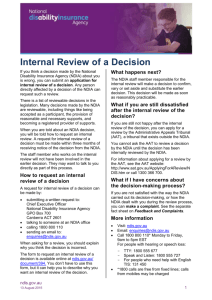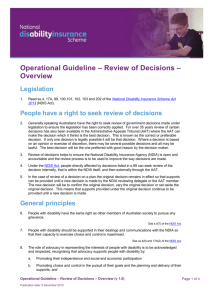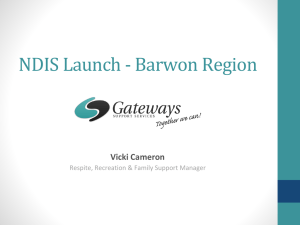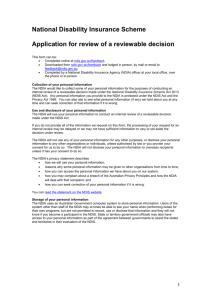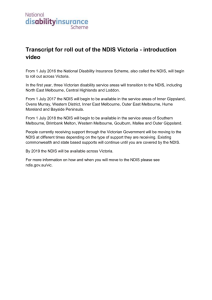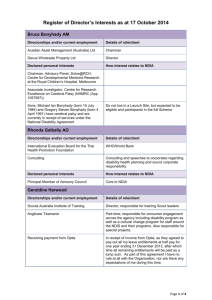Making the internal review decision
advertisement
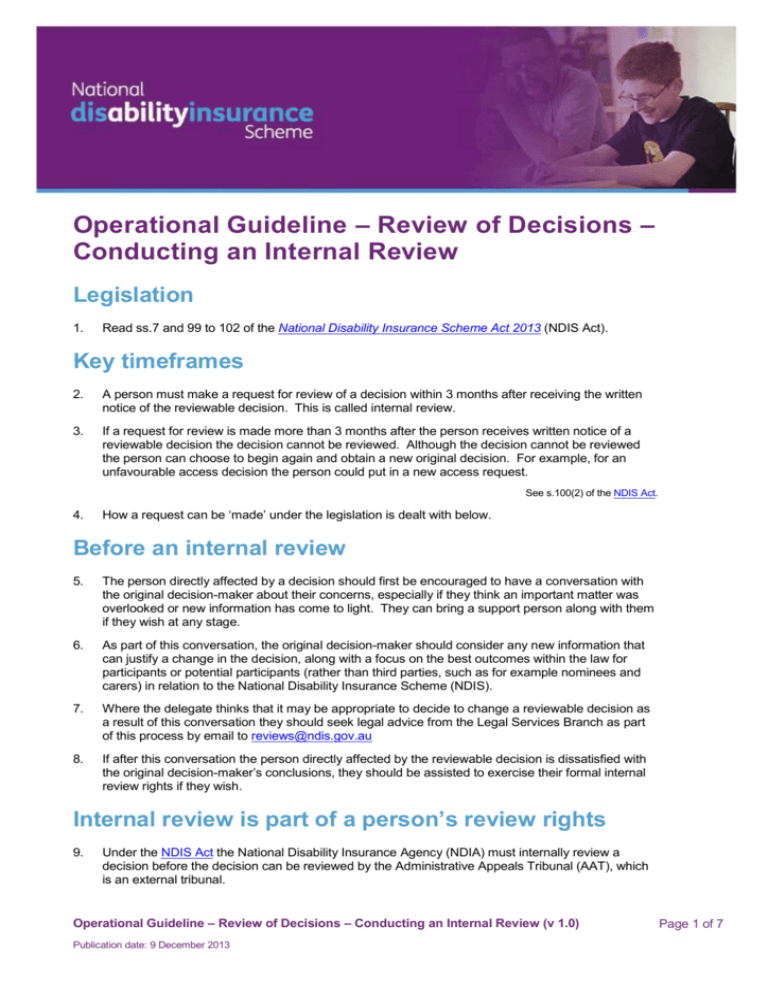
Operational Guideline – Review of Decisions – Conducting an Internal Review Legislation 1. Read ss.7 and 99 to 102 of the National Disability Insurance Scheme Act 2013 (NDIS Act). Key timeframes 2. A person must make a request for review of a decision within 3 months after receiving the written notice of the reviewable decision. This is called internal review. 3. If a request for review is made more than 3 months after the person receives written notice of a reviewable decision the decision cannot be reviewed. Although the decision cannot be reviewed the person can choose to begin again and obtain a new original decision. For example, for an unfavourable access decision the person could put in a new access request. See s.100(2) of the NDIS Act. 4. How a request can be ‘made’ under the legislation is dealt with below. Before an internal review 5. The person directly affected by a decision should first be encouraged to have a conversation with the original decision-maker about their concerns, especially if they think an important matter was overlooked or new information has come to light. They can bring a support person along with them if they wish at any stage. 6. As part of this conversation, the original decision-maker should consider any new information that can justify a change in the decision, along with a focus on the best outcomes within the law for participants or potential participants (rather than third parties, such as for example nominees and carers) in relation to the National Disability Insurance Scheme (NDIS). 7. Where the delegate thinks that it may be appropriate to decide to change a reviewable decision as a result of this conversation they should seek legal advice from the Legal Services Branch as part of this process by email to reviews@ndis.gov.au 8. If after this conversation the person directly affected by the reviewable decision is dissatisfied with the original decision-maker’s conclusions, they should be assisted to exercise their formal internal review rights if they wish. Internal review is part of a person’s review rights 9. Under the NDIS Act the National Disability Insurance Agency (NDIA) must internally review a decision before the decision can be reviewed by the Administrative Appeals Tribunal (AAT), which is an external tribunal. Operational Guideline – Review of Decisions – Conducting an Internal Review (v 1.0) Publication date: 9 December 2013 Page 1 of 7 10. Most decisions made under the NDIS Act can be subjected to internal review and may then be reviewable by the AAT. The list of reviewable decisions is in s.99 of the NDIS Act. The AAT cannot review a decision unless legislation gives the AAT jurisdiction to review that particular decision. For example, plan management decisions are not separately reviewable by the AAT but are reviewed as part of the plan decision (see s.99(d)). See ss.99 and 103 of the NDIS Act. 11. There are a number of consequences that follow from a decision being a reviewable decision: a. It is a person directly affected by the decision who must decide whether to exercise those review rights and have a decision reviewed b. The original decision is subject to internal review by the NDIA. It is the internal review decision that the AAT can then review if requested. The AAT does not review the original decision. The AAT is said to review the original decision as reviewed by the internal reviewer, and c. There are a number of obligations and timeframes that apply to the original decision and the internal review decision (see below). See ss.100 to 103 of the NDIS Act. Internal review is the second level in a three level decision process 12. There are three levels of decision: a. The original decision – this is the first decision made by a delegate in the NDIA b. The internal review decision – this is the second decision and is made by a delegate in the NDIA after the delegate has reviewed the original decision, and c. The AAT review decision – this is the third decision and is made externally to the NDIA by a member of the AAT. 13. At each of the three levels the delegate or AAT member considers the material before them at the time they make the decision. 14. The later a review occurs in the process the greater the quantity of information is that will be available to the decision-maker. 15. A participant or prospective participant involved in the review process at each level will be encouraged to speak with the NDIA delegate or the AAT member about why they are not happy about the decision and to present further information to support their case. 16. At each of the three levels the NDIA delegate or AAT member is required to make the decision that they consider to be the best decision on the merits. This is the correct or preferable decision. If only one decision is legally possible it will be that decision. Where a decision is based on an opinion or exercise of discretion, there may be several possible decisions and all may be lawful. The best decision will be the one preferred with good reason by the decision-maker. 17. The outcome of an internal review or AAT review is that a new decision-maker makes a new decision that replaces the earlier decision. The new decision, whether made by the internal reviewer or by the AAT will be to confirm, vary or set aside the earlier decision. See s.100(6) of the NDIS Act. 18. It should be noted that plan decisions cannot be varied under section 37(2) of the NDIS Act and can only be confirmed or replaced by a new plan decision. If replacement occurs after a review has Operational Guideline – Review of Decisions – Conducting an Internal Review (v 1.0) Publication date: 9 December 2013 Page 2 of 7 been sought and is being considered by an internal review officer or the AAT, but no review decision has yet been made, the review body reviews the replacement plan unless the applicant withdraws the review application. Notice of review rights 19. When a delegate makes the original decision the delegate is required to give a notice to an affected person which includes a statement that: a. The person may request internal review of the decision; and b. If they are still not satisfied with the internal review decision, the person may request the AAT to review the internal review decision. See s.100(1) of the NDIS Act. 20. Prior to requesting internal review a participant or prospective participant may have a conversation with the decision-maker about the decision. This is optional and it is an opportunity for the decision-maker and the affected person to discuss the decision. At this stage the delegate can explain the decision in more detail and the participant or prospective participant can present other information to support their case or explore where more weight should have been given to other factors or evidence. 21. Where the delegate thinks that it may be appropriate to decide to change the reviewable decision as a result of this conversation they should seek legal advice from the Legal Services Branch at reviews@ndis.gov.au as part of this process. How a request for internal review can be made 22. A request may be made: a. By sending a written request, which includes by email, to the NDIA b. By delivering a written request to the NDIA, or c. Orally (see paragraphs 22 and 23 below). 23. It is enough to make a request for review that a person sends the request to the NDIA, a particular office, branch or person. In cases where it is unclear whether the person sent the request within the 3 month time limit, delegates are to obtain whatever factual information they can, preferably written evidence, and determine as a matter of fact whether the request was sent to the NDIA within the time limit. See s.100(3) of the NDIS Act. A request for review may be made orally 24. A person may also make a review request by making an oral request in person, over the phone or by any other means to the NDIA. 25. The NDIA officer receiving an oral request must make a written record of the request which notes the details and the day the request is made. See ss.100(3) and 100(4) of the NDIS Act. 26. Where support is requested or required to assist the person make a review request the NDIA officer receiving the oral request will arrange or provide the support needed such as an interpreter or requesting a support person to assist the person making the request. Operational Guideline – Review of Decisions – Conducting an Internal Review (v 1.0) Publication date: 9 December 2013 Page 3 of 7 Automatic review when timeframes in the legislation are not met 27. There are two decisions in the legislation that are reviewed automatically when the NDIA fails to meet timeframes: a. An access request is taken not to meet the access criteria if the timeframe of 21 days in s.21(3) is not met, or b. A participant’s request to review their plan is taken to be refused if the 14 day timeframe in s.48(2) is not met. See s.100(5) (b) of the NDIS Act. 28. These time frames are doubled for the initial 12 month period of operation for each host jurisdiction. The National Disability Insurance Scheme (Timeframes for Decision-making) Rules 2013 (Timeframes for Decision-making Rules) provides for the additional time periods. See r.3.3 of the Timeframes for Decision-making Rules. The internal review decision must be made by a new decision-maker 29. When the NDIA receives a request for review, the NDIA has an obligation to conduct an internal review and make a decision. A delegate is appointed under s.100 who was not involved in the making of the original decision. 30. NDIA delegates are discouraged from discussing or disclosing information about individual cases to other NDIA delegates not involved in the decisions related to that individual. Clearly delegates are expected to discuss matters with direct line managers and where necessary subject matter experts at the national level. This ensures the integrity of the internal review process and is required by the Commonwealth Privacy Act 1988. See s.100(5)(b) of the NDIS Act. Varying the original decision does not stop the review 31. If the original decision is varied by a delegate before the internal review decision is made the internal review does not stop. The internal review continues and is a review of the original decision as varied by the delegate. Note that this does not apply to plan decisions under the NDIS Act. If a plan is replaced after the application for review has occurred after a review has been sought and is being considered by an internal review delegate, but no review decision has yet been made, the review body reviews the replacement plan unless the applicant withdraws the review application. See s.101 of the NDIS Act. The request for review can be withdrawn 32. A request may be withdrawn at any time by the person: a. By sending a written request to the NDIA b. By delivering a written request to the NDIA, or Operational Guideline – Review of Decisions – Conducting an Internal Review (v 1.0) Publication date: 9 December 2013 Page 4 of 7 c. Contacting the NDIA orally in person, over the phone or by any other means. 33. If the withdrawal of the request is oral, the NDIA must make a written record of the withdrawal which notes the details and the day the withdrawal is made. See s.102 of the NDIS Act. Making the internal review decision 34. The delegate for an internal review must, as soon as reasonably practicable, make a decision to: a. Confirm the reviewable decision b. Vary the reviewable decision, or c. Set aside the reviewable decision and substitute a new decision. See s.100(6) of the NDIS Act. The delegate is to draft a statement of reasons for the internal review decision 35. The delegate is required to give the person involved a notice about the internal review decision. The notice must include a statement of reasons that includes: a. The findings on material questions of fact b. The evidence or other material on which those finding were based, and c. The reasons for the decision. See ss.28 and 29(2) of the Administrative Appeals Tribunal Act 1975 (AAT Act). 36. Where the review decision is to change the original decision, the reasons for the review decision are to be checked and cleared by the NDIA’s Legal Services Branch to ensure any legal risks are managed appropriately. Legal Services Branch can be contacted for this purpose through reviews@ndis.gov.au. The internal review decision must include a notice of AAT review rights 37. The delegate is required to give the affected person notice of the internal review decision. This includes notice of appeal rights including that the person may request the AAT to review the internal review decision. 38. This will almost always be in the form of a leaflet on review rights that accompanies the notice of decision. See ss.28 and 29(2) of the AAT Act. The approach to conducting the internal review and making better decisions 39. The NDIA wants to ensure that each decision is: Operational Guideline – Review of Decisions – Conducting an Internal Review (v 1.0) Publication date: 9 December 2013 Page 5 of 7 a. b. Legally valid. This means delegates are to: i. Apply the legislation correctly; and ii. Comply with the legal requirements that apply when making decisions in the exercise of powers in the legislation. These principles are called the administrative law principles, and The best decision on the merits as explained in paragraph 16 above. 40. Administrative law principles refer to the standards expected of government decision-makers in the process of coming to a decision that is fair and reasonable to all parties affected by the decision. At the core of these principles are the notions of natural justice and procedural fairness. These considerations are discussed in detail in Operational Guideline – Review of Decisions – Making Better Decisions. 41. Delegates should follow the process below in considering their decision: a. Identify the power to make the decision – identify the legislation that applies and the ‘test’ or criteria for the decision set out in the legislation b. Ensure that they have a delegation to make the decision and are free from bias c. Identify and comply with the prerequisites or pre-conditions for making the decision which will be set out in the NDIS Act, the NDIS Rules, Operational Guidelines or standard operating procedures d. Identify and comply with these prerequisites or pre-conditions in making the decision (i.e. follow the procedures in making the decision). e. Gather the material needed in order to make the decision f. Weigh the material and reach findings of fact, meaning take each criterion and work out whether the material available suggests that the criterion is satisfied g. Consider any known relevant NDIA policies, and h. Make the decision and document the decision. See Operational Guideline – Review of Decisions — Making Better Decisions. 42. Where a reviewable decision involves complex or novel factors, the NDIA delegates should consult with the national policy area and where required they will refer the matter to the expert panel to seek their input. 43. The legislation requires that the contents of any notice, approved form or information given under the NDIS Act or the NDIS Rules to a person with disability must be explained by the NDIA delegate to the maximum extent possible in the language, mode of communication and terms which that person is most likely to understand. 44. Wherever reasonably practical, this will be done as part of a conversation between the NDIA delegate and the affected person. There will also be an explanation provided in writing. See s.7 of the NDIS Act. 45. The process for review should be an informal and easy to understand conversation and provide the person with an opportunity to have their say. The delegate is to take all reasonable steps to contact the person to discuss the matters under review. It should be conducted in a way that is best suited to the circumstances of the person seeking review. In some instances a support person will be present where the person makes a request for a support person or there is a recognised need for a support person. Operational Guideline – Review of Decisions – Conducting an Internal Review (v 1.0) Publication date: 9 December 2013 Page 6 of 7 46. In some other instances it may be that the review process is conducted on the telephone, on the papers (rarely) or at an NDIA office. In some situations, such as where participants are involved, it may be appropriate to attend the person’s home if requested. 47. A key part of this review process is that this conversation considers available options to provide solutions and does not always focus on the decision itself. This is consistent with the key objectives and principles of the NDIS. 48. The reviewable decision, and any action to implement it, takes effect despite the request for review and operates pending the outcome of the review. See s.100(7) of the NDIS Act. Operational Guideline – Review of Decisions – Conducting an Internal Review (v 1.0) Publication date: 9 December 2013 Page 7 of 7
